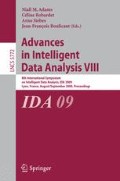Abstract
Measuring the spatial distribution of locations of many entities (trees, atoms, economic activities, ...), and, more precisely, the deviations from purely random configurations, is a powerful method to unravel their underlying interactions. I study here the spatial organization of retail commercial activities. From pure location data, network analysis leads to a community structure that closely follows the commercial classification of the US Department of Labor. The interaction network allows to build a ’quality’ index of optimal location niches for stores, which has been empirically tested.
Access this chapter
Tax calculation will be finalised at checkout
Purchases are for personal use only
Preview
Unable to display preview. Download preview PDF.
References
Hoover, E.M.: Location Theory and the Shoe and Leather Industries. Harvard University Press, Cambridge (1937)
Egami, T., Billinge, S.: Underneath the Bragg Peaks: Structural Analysis of Complex Materials. Pergamon Materials Series (2003)
Ward, J.S., Parker, G.R., Ferrandino, F.J.: Long-term spatial dynamics in an old-growth deciduous forest. Forest ecology and management 83, 189–202 (1996)
Hoover, E.M., Giarratani, F.: An Introduction to Regional Economics (1984)
Jensen, P.: Network-based predictions of retail store commercial categories and optimal locations. Physical Review E (Statistical, Nonlinear, and Soft Matter Physics) 74 (2006)
Ripley, B.D.: The second-order analysis of stationary point processes. Journal of Applied Probability 13, 255–266 (1976)
Besag, J.E.: Comments on ripley’s paper. Journal of the Royal Statistical Society B 39, 193–195 (1977)
Ellison, G., Glaeser, E.L.: Geographic concentration in us manufacturing industries: A dartboard approach. Journal of Political Economy 105, 889–927 (1997)
Maurel, F., Sedillot, B.: A measure of the geographic concentration of french manufacturing industries. Regional Science and Urban Economics 29, 575–604 (1999)
Duranton, G., Overman, H.G.: Testing for localisation using micro-geographic data. The Review of Economic Studies 72, 1077 (2005)
Marcon, E., Puech, F.: Measures of the geographic concentration of industries: improving distance-based methods (2007)
Yule, G.U., Kendall, M.G.: An Introduction to the Theory of Statistics. Griffin, London (1950)
Unwin, D.J.: Gis, spatial analysis and spatial statistics. Progress in Human Geography 20, 540–551 (1996)
Openshaw, S.: The Modifiable Areal Unit Problem. Geo Books, Norwich (1984)
Briant, A., Combes, P.P., Lafourcade, M.: Do the size and shape of spatial units jeopardize economic geography estimations (2007)
Barthelemy, M., Barrat, A., Pastor-Satorras, R., Vespignani, A.: Rate equation approach for correlations in growing network models. Physica A 346 (2005)
Marcon, E., Puech, F.: Measures of the geographic concentration of industries: Improving distance-based methods (2007)
Berry, B.J., Parr, J.B., Epstein, B.J., Ghosh, A., Smith, R.H.: Market Centers and Retail Location: Theory and Application. Prentice-Hall, Englewood Cliffs (1988)
Reichardt, J., Bornholdt, S.: Detecting fuzzy communities in complex networks with a potts model. Phys. Rev. Lett. 93 (2004)
Radicchi, F., Castellano, C., Cecconi, F., Loreto, V., Parisi, D.: Defining and identifying communities in networks. Publ. Natl. Acad. Sci. USA 101, 2658–2663 (2004)
Kirkpatrick, S., Gelatt Jr., C.D., Vecchi, M.P.: Optimization by simulated annealing. Science 220, 671 (1983)
Newman, M.E.J., Girvan, M.: Community structure in social and biological networks. Proceedings of the National Academy Science USA 69, 7821–7826 (2004)
Author information
Authors and Affiliations
Editor information
Editors and Affiliations
Rights and permissions
Copyright information
© 2009 Springer-Verlag Berlin Heidelberg
About this paper
Cite this paper
Jensen, P. (2009). Analyzing the Localization of Retail Stores with Complex Systems Tools. In: Adams, N.M., Robardet, C., Siebes, A., Boulicaut, JF. (eds) Advances in Intelligent Data Analysis VIII. IDA 2009. Lecture Notes in Computer Science, vol 5772. Springer, Berlin, Heidelberg. https://doi.org/10.1007/978-3-642-03915-7_2
Download citation
DOI: https://doi.org/10.1007/978-3-642-03915-7_2
Publisher Name: Springer, Berlin, Heidelberg
Print ISBN: 978-3-642-03914-0
Online ISBN: 978-3-642-03915-7
eBook Packages: Computer ScienceComputer Science (R0)

